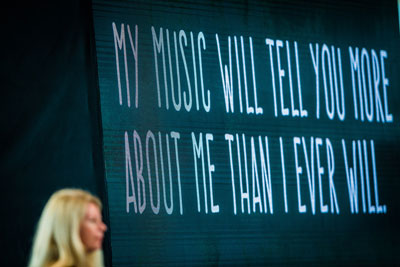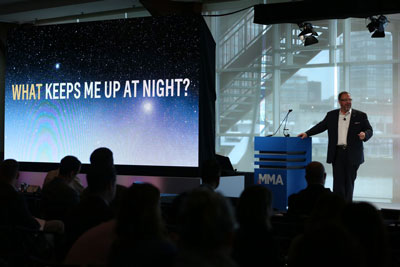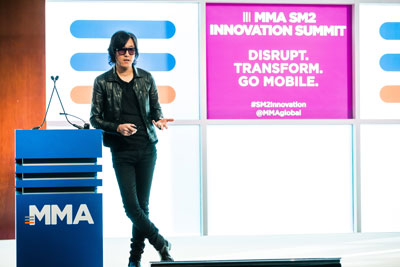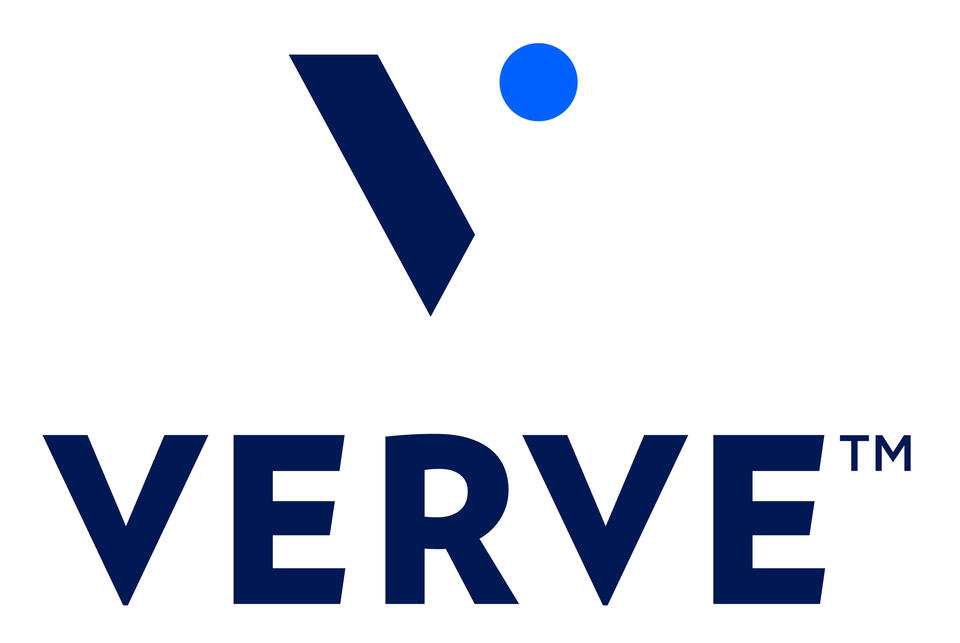The Mobile Marketing Association’s annual SM2 Innovation Summit was the place to be during New York’s Advertising Week for brands, agencies and ad tech providers who wanted to hear the hottest insights in mobile. Hundreds of attendees heard from some of marketing’s biggest boldfaced names, including AOL CEO Tim Armstrong, Chevrolet CMO Tim Mahoney, ex-Pandora exec Heidi Browning (now CMO of the National Hockey League, Allstate Marketing EVP Sanjay Gupta, and POSSIBLE Global Chief Creative Officer Daniel Chu.
Collectively, the speakers emphasized the transformational nature of mobile – from its ability to empower individuals to the ways it is altering every corner not just of marketing, but of business itself. No one put the Summit’s context in Advertising Week better than Armstrong. In the opening session, he explained: “Probably this event in this room is the most important one for the future.”
Below are ten key takeaways from the Summit’s two days:
- Mobile may just transform your entire organization. While many marketers are thinking of mobile as a marketing challenge, for others, it is changing their businesses, including their internal structures. “Mobile can transform not just the products but your entire organization,” noted Allstate’s Gupta. At Allstate, disciplines such as agile development, internal user experience design, digital content and internal consultants have been co-located. He believes mobile is transforming everything across the board at the company.
FedEx Marketing EVP Rajesh Subramanium noted during his session how mobile is changing the company’s very mission -- as it can give a global footprint to even the most regional businesses. “Our mission is a lot bigger than delivering packages,” he said. “It’s connecting businesses around the world.”
 Mobile is giving scale a whole different scale. “Scale in the mobile world is going to be dramatically different,” noted AOL’s Armstrong in his onstage interview with Bloomberg’s Cory Johnson. The next wave of consumers to go online – an estimated three billion of them – will primarily do so through mobile; that’s one reason AOL combined with Verizon and soon will with Yahoo! “We want to basically hit a big audience and we want to be associated with companies that bring an advantage to mobile,” Armstrong explained.
Mobile is giving scale a whole different scale. “Scale in the mobile world is going to be dramatically different,” noted AOL’s Armstrong in his onstage interview with Bloomberg’s Cory Johnson. The next wave of consumers to go online – an estimated three billion of them – will primarily do so through mobile; that’s one reason AOL combined with Verizon and soon will with Yahoo! “We want to basically hit a big audience and we want to be associated with companies that bring an advantage to mobile,” Armstrong explained.
- The shelf life of a downloaded app may be only a matter of days. Happy that users are downloading your app? Not so fast. If downloaders don’t start engaging with it, right away, it could go away just as quickly. This may be especially true of younger demographics. “If it doesn’t prove its utility in 72 hours [mobile prodigies] delete it.” said Home Depot Media Strategy Manager Yvette Davis during a co-presentation with Julie Bernard, CMO of Verve.
By other accounts, the shelf-life of apps may be even shorter. Almighty’s Rob Griffin said that 75 percent of app users are done after Day 2 of a download and Phil Gordon, CEO of Chatbox, said only 30 percent of people will use an app after the first day they’ve downloaded it. Whatever the most accurate statistic, the picture is clear: brands need to make their apps engaging and useful on an ongoing basis, and do it right out of the gate.
 Gen Z is different than you and me -- and mobile marketers need to take notice. As Heidi Browning, formerly of Pandora, said: “They truly believe they will change the world in their pajamas.” Browning, who presented a study by Pandora on Gen Z, also noted that they listen to seven genres of music per week – far more than older generations – and that 87% listen to music while they are doing homework.
Gen Z is different than you and me -- and mobile marketers need to take notice. As Heidi Browning, formerly of Pandora, said: “They truly believe they will change the world in their pajamas.” Browning, who presented a study by Pandora on Gen Z, also noted that they listen to seven genres of music per week – far more than older generations – and that 87% listen to music while they are doing homework.
Bernard and Davis’ companion presentation on “mobile prodigies” – Gen Z with a smattering of millennials – further emphasized mobile’s central role in the demo’s lives. “Their device is part of their persona,” noted Bernard. When the study asked 3000 of the group what screen -- TV or mobile -- they would keep if they could only hold onto one: not one of them picked the TV.
They also are data savvy and willing to share it “ … if they understand the benefit,” Bernard said.
- Even the most established brands need to participate in the sharing economy. As AllState’s Gupta said during his presentation, “There’s no denying the sharing economy is taking off.” He cited the company’s Uber-like app feature, which allows drivers to follow the progress of a tow truck. Allstate has also brought the concept of sharing to roadside assistance that doesn’t require a tow truck, having trained people to help with lesser concerns, like flat tires.
 Chevrolet’s Mahoney also cited the sharing economy during his presentation, particularly GM’s investment in Lyft, which – to previous generations of GM executives – might have been seen solely as a competitor. ”We’re thinking about customer solutions from [the customer’s] perspective, not necessarily ours,” he said.
Chevrolet’s Mahoney also cited the sharing economy during his presentation, particularly GM’s investment in Lyft, which – to previous generations of GM executives – might have been seen solely as a competitor. ”We’re thinking about customer solutions from [the customer’s] perspective, not necessarily ours,” he said.
- Not buying mobile programmatically? You will be. DataXu’s Adam Markey and Priti Ohri cited this fascinating statistic from eMarketer during a breakout session on programmatic TV: 83 percent of mobile will be bought programmatically by 2018. Programmatic is, of course, a gateway to buying cross-device. Data they cited from eConsultancy showed that at present, 47 percent of senior marketers view using programmatic to buy across devices as either “critical” or “very important.”
- These days, sandwich shops have incredible mobile experiences. In 2016, it’s not only major brands that can create great mobile websites. David-Michel Davies, CEO of The Webby Media Group (yes, the Webbys), noted his surprise and delight when he discovered that his favorite sandwich shop, Eisenberg’s, had a great, responsive mobile experience, featuring online-ordering, one-touch walking directions and a 360-degree tour. Davies prodded the audience to move away from the sameness that is starting to dominate user interfaces, and provide users with experiences that are useful, helpful and immersive. “Aim high or risk being overlooked,” he warned.
- Data is what’s driving great creative and great user experiences. If the testimony of several agency creatives who spoke at SM2 is any guide, the age of data-driven creative is (finally) here. “Using data in meaningful ways is like the caviar and champagne of mobile marketing,” explained Matt Murphy, Partner and Executive Creative Director at 72andSunny during his presentation on mobile creative. He was one of several speakers who referenced the Smarties-winning Spotify Singles campaign as a great example of data in action. The initiative used Spotify’s data to start programs such as “Found It First,” which took listening data to demonstrate which individual users were into an artist before they were famous – and also let the artist know.
 POSSIBLE’s Chu noted that he joined the agency because of its data-driven focus. During his closing talk on data-driven creative, he detailed how the agency was able to use Microsoft and Facebook data to figure out not only who used MS’ OneNote as they were developing a campaign for it, but also found a person who became the campaign’s focus and then used data to expand the target of the campaign. His advice to marketers? “If your agency doesn’t embrace data, replace them.”
POSSIBLE’s Chu noted that he joined the agency because of its data-driven focus. During his closing talk on data-driven creative, he detailed how the agency was able to use Microsoft and Facebook data to figure out not only who used MS’ OneNote as they were developing a campaign for it, but also found a person who became the campaign’s focus and then used data to expand the target of the campaign. His advice to marketers? “If your agency doesn’t embrace data, replace them.”
- Messaging apps have surpassed the traffic to social networks. Even as social media apps remain one of the main things people access on their mobile devices, here’s why there’s so much hype about messaging apps: they are already larger than social. Chatbox’s Phil Gordon cited these statistics from BI Intelligence during his session on messaging: by the third quarter of 2015, the four biggest global messaging apps – Facebook Messenger, Line, WeChat and WhatsApp – had three billion monthly active users. The four biggest social networks had 2.5 billion MAUs.
- Mobile is not just a media channel. Perhaps it’s obvious from the previous takeaways, but marketers who are thinking of mobile solely as a marketing channel are missing the point. It provides utility – as evidenced by Allstate’s roadside assistance app, disruption – as demonstrated by the effect services like Uber and Lyft are having on the automotive industry, and transformation – as it is enabling small businesses to become global ones. As Almighty’s Griffin put it during his talk on mobile ubiquity: “It’s sort of everything. It’s not a stand-alone media channel. At the end of the day, it’s the remote control of my life.”
If you’d like to be updated on 2017’s SM2 Innovation Summit, click here, and for the full schedule of MMA events throughout the world, check out this link.





























